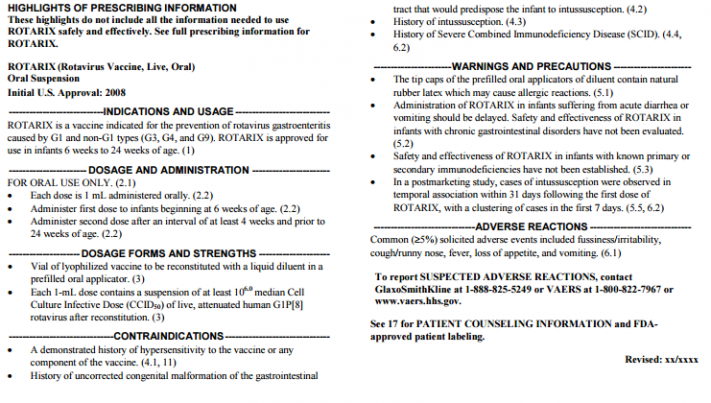
Rotarix: Rotavirus Vaccine, Live, Oral: patient information, prescribing information, ingredients, manufacturer, adverse reactions and side effects
Tuesday, April 11, 2017 by Gregory Van Dyke
http://www.naturalnewsreference.com/2017-04-11-rotarix-rotavirus-vaccine-live-oral-patient-information-prescribing-information-ingredients-manufacturer-adverse-reactions-and-side-effects.html

HIGHLIGHTS OF PRESCRIBING INFORMATION
These highlights do not include all the information needed to use ROTARIX safely and effectively. See full prescribing information for ROTARIX.
See full insert sheet at this link at the Natural News Reference website.
ROTARIX(Rotavirus Vaccine, Live, Oral)
Oral Suspension
Initial U.S. Approval: 2008
INGREDIENTS AND EXCIPIENTS
ROTARIX (Rotavirus Vaccine, Live, Oral), for oral administration, is a live, attenuated rotavirus vaccine derived from the human 89-12 strain which belongs to G1P[8] type. The rotavirus strain is propagated on Vero cells. After reconstitution, the final formulation (1 mL) contains at least 106.0 median Cell Culture Infective Dose (CCID50) of live, attenuated rotavirus.
The lyophilized vaccine contains amino acids, dextran, Dulbecco’s Modified Eagle Medium (DMEM), sorbitol, and sucrose. DMEM contains the following ingredients: sodium chloride, potassium chloride, magnesium sulfate, ferric (III) nitrate, sodium phosphate, sodium pyruvate, D-glucose, concentrated vitamin solution, L-cystine, L-tyrosine, amino acids solution, L- glutamine, calcium chloride, sodium hydrogenocarbonate, and phenol red.
In the manufacturing process, porcine-derived materials are used. Porcine circovirus type 1 (PCV-1) is present in ROTARIX. PCV-1 is not known to cause disease in humans.
The liquid diluent contains calcium carbonate, sterile water, and xanthan. The diluent includes an antacid component (calcium carbonate) to protect the vaccine during passage through the stomach and prevent its inactivation due to the acidic environment of the stomach.
ROTARIX is available in single-dose vials of lyophilized vaccine, accompanied by a prefilled oral applicator of liquid diluent [see How Supplied/Storage and Handling (16)]. The tip caps of the prefilled oral applicators contain natural rubber latex; the vial stoppers are not made with natural rubber latex.
ROTARIX contains no preservatives.
INDICATIONS AND USAGE
ROTARIX is a vaccine indicated for the prevention of rotavirus gastroenteritis caused by G1 and non-G1 types (G3, G4, and G9). ROTARIX is approved for use in infants 6 weeks to 24 weeks of age. (1)
DOSAGE AND ADMINISTRATION
FOR ORAL USE ONLY. (2.1)
– Each dose is 1 mL administered orally. (2.2)
– Administer first dose to infants beginning at 6 weeks of age. (2.2)
– Administer second dose after an interval of at least 4 weeks and prior to 24 weeks of age. (2.2)
DOSAGE FORMS AND STRENGTHS
– Vial of lyophilized vaccine to be reconstituted with a liquid diluent in a prefilled oral applicator. (3)
– Each 1-mL dose contains a suspension of at least 106.0 median Cell Culture Infective Dose (CCID50) of live, attenuated human G1P[8] rotavirus after reconstitution. (3)
CONTRAINDICATIONS
– A demonstrated history of hypersensitivity to the vaccine or any component of the vaccine. (4.1, 11)
– History of uncorrected congenital malformation of the gastrointestinal tract that would predispose the infant to intussusception. (4.2)
– History of intussusception. (4.3)
– History of Severe Combined Immunodeficiency Disease (SCID). (4.4, 6.2)
WARNINGS AND PRECAUTIONS
The tip caps of the prefilled oral applicators of diluent contain natural rubber latex which may cause allergic reactions. (5.1)
Administration of ROTARIX in infants suffering from acute diarrhea or vomiting should be delayed. Safety and effectiveness of ROTARIX in infants with chronic gastrointestinal disorders have not been evaluated. (5.2)
Safety and effectiveness of ROTARIX in infants with known primary or secondary immunodeficiencies have not been established. (5.3)
In a postmarketing study, cases of intussusception were observed in temporal association within 31 days following the first dose of ROTARIX, with a clustering of cases in the first 7 days. (5.5, 6.2)
ADVERSE REACTIONS
Common (≥5%) solicited adverse events included fussiness/irritability, cough/runny nose, fever, loss of appetite, and vomiting. (6.1)
To report SUSPECTED ADVERSE REACTIONS, contact GlaxoSmithKline at 1-888-825-5249 or VAERS at 1-800-822-7967 or www.vaers.hhs.gov.
USE IN SPECIFIC POPULATIONS
Pregnancy
Pregnancy Category C: Animal reproduction studies have not been conducted with ROTARIX. It is also not known whether ROTARIX can cause fetal harm when administered to a pregnant woman or can affect reproduction capacity.
Pediatric Use
Safety and effectiveness of ROTARIX in infants younger than 6 weeks or older than 24 weeks of age have not been evaluated.
The effectiveness of ROTARIX in pre-term infants has not been established. Safety data are available in pre-term infants (ROTARIX = 134, placebo = 120) with a reported gestational age ≤36 weeks. These pre-term infants were followed for serious adverse events up to 30 to 90 days after Dose 2. Serious adverse events were observed in 5.2% of recipients of ROTARIX as compared with 5.0% of placebo recipients. No deaths or cases of intussusception were reported in this population.
Revised: xx/xxxx
https://www.fda.gov/downloads/BiologicsBloodVaccines/Vaccines/ApprovedProducts/UCM133539.pdf
http://naturalnewsreference.com/vaccine-insert-sheets/Rotarix.pdf
Tagged Under: Tags: dosage, ingredients, insert sheet, rotarix, side effects, usage, warnings





